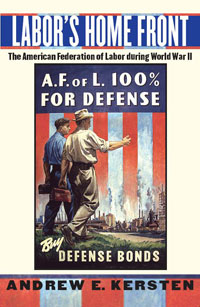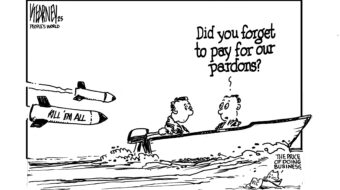
The history of labor during wartime is an enticing subject. The history of labor during World War II is especially so, as that war in particular is considered the “Good War.” It was the war against fascist brutality and Jewish extermination, and for “Big D” democracy. So labor’s response, at least in my view, takes on a more profound meaning and is well worth continued research.
In this context, Andrew E. Kersten’s Labor‘s Home Front: The American Federation of Labor during World War II is an important study of the AFL, its affiliate members and the international unions that constituted its governing bodies, and how they responded to workers’ rights and unionization campaigns during the war.
Like most Americans, as well as the AFL’s then rival – the Congress of Industrial Organizations (CIO) – the AFL initially took an isolationist stance towards “the European War.” However, by the time of the Pearl Harbor bombing “the AFL was staunchly pro-defense.”
The AFL’s support of President Roosevelt and the war effort did not come without a price, though, as “The AFL’s leadership wanted to make certain that in the defense emergency, all stakeholders shared the burden of making policy decisions. No unionist wanted to return to the situation of the First World War, during which employers and their government allies, no matter how progressive, basically ran the show,” and it must be added, profited handsomely from the wartime production boom, while workers’ wages stagnated or declined.
Undoubtedly, the AFL wasn’t alone in this perspective, as “both houses of labor [the AFL and the CIO] demanded that the work of the war must be shared and that no one group unduly profit….” Nevertheless, the AFL was not above outmaneuvering, undermining and undercutting the rival CIO and its members.
For example, in July 1941 the AFL’s Building and Construction Trades Department “signed an incredible and exclusive industry stabilization agreement that affected 1.5 million Federation unionists.” Called an “epochal pact” by AFL leaders, the contract “was essentially a closed-shop agreement between the Building and Construction Trades Department and the U.S. government for the construction of all defense-related building. In other words, only AFL unionists were to work on any structure constructed for the defense emergency.”
While this was quite an agreement – one that undoubtedly provided 1.5 million AFL union members and their families with job security – it was also a double-edged sword, as the AFL also made “major sacrifices.” First, the Federation agreed to a no-strike pledge, which many unionists – and some radical groups, like the Communist Party – supported. Second, they agreed to “obey the federal government’s plan for job and material allocations,” which meant that federal managers, not workers, determined how much material and time should be allocated for job completion.
This agreement undoubtedly led to resentment and conflict, as workers – often against the wishes of both AFL and CIO leaders – engaged in work stoppages and strikes. Throughout the course of the war there were a total of 14,731 work stoppages and strikes involving 6.7 million workers.
Workplace safety was often the main point of contention. For, as Kersten wrote, “Quite literally, during the first few years of the Second World War, it was safer for Americans to be on the battlefield than it was for them to work on the home front of the arsenal of democracy.”Workplace deaths during the war averaged between 17,800 and 20,100 peryear; 1943 saw the highest number of wartime workplace deaths. Further, a staggering 2 million workplace injuries and/or disabilities occurred peryear during the war.
After a general overview, or macro-perspective, of wartime labor relations, Kersten shifts gears and provides a micro-level analysis of one AFL union and its wartime policies regarding equality and inclusion of African Americans. The chapter titled “Building Ships for Democracy: The AFL, the Boilermakers, and Wartime Racial Justice in Portland and Providence” illuminates how individual Boilermaker locals in Portland, Ore. and Providence, R.I. handled issues of race, racism, inclusion and exclusion, as well as the union’s national leadership’s role in maintaining racism within the union – even going so far as to throwout union election ballots cast by African American members!
Kersten then shifts gears again to focus on the wartime animosity between the AFL and the CIO, and how “the leadership of both…did not push hard for women’s issues,” though “this was especially true of the American Federation of Labor.”
In all, Kersten’s Labor‘s Home Front is a critical understanding of wartime and labor history generally. Some mild criticisms are warranted, including the absence of an analysis of how leftist forces, especially the Communist Party – as well as right-wing forces – influenced the overall direction of the AFL, its affiliated international unions and/or union locals. For example, it is widely understood today that communists played a foremost role in some CIO unions during the war; it would have been interesting to learn about similar influence in AFL unions – from the CPor otherwise.
However, minus this minor shortcoming, Labor‘s Home Front is a welcome contribution to American labor history.
Labor‘s Home Front: The American Federation of Labor during World War II
Andrew E. Kersten
New York University Press, 2006, 274 pages










